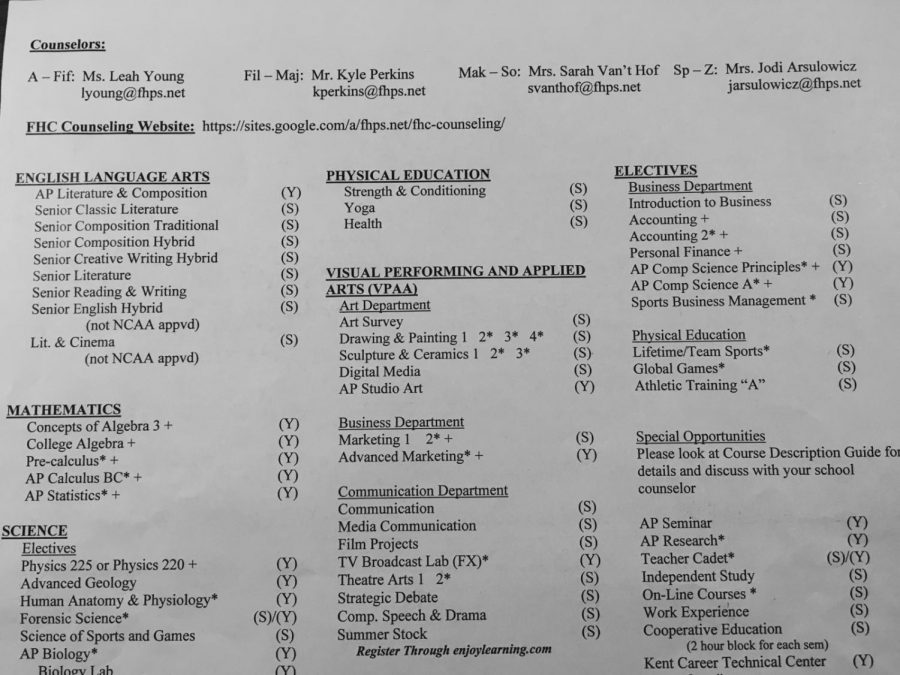Scheduling showcase: does it allow students to choose classes more wisely?

More stories from Olivia Luplow
As sophomore Sarah Chesner stared down at her blank, blue sheet of paper, the seemingly millions of class choices threatened to overwhelm her. The idea of choosing an entire year of classes with limited ideas of what they are actually like is entirely daunting. How could she even know where to start?
Sarah, along with the rest of the student body, faces these important and influential decisions every year in early March. For years, this process was comprised of mistakes, flaws, and a stream of endless changes for unhappy students. For the past two years, though, the administrative body has worked to change that.
Now in its second year of operation, the Scheduling Showcase provides students and teachers with peace of mind regarding class choice decisions.
“I thought it was pretty good to be able to learn about classes that we can take next year,” Sarah said. “Hearing the teachers talk showed me if they’re a good teacher and what they’ll teach in their class next year.”
According to Sarah, the Scheduling Showcase has done its job. It still remains far from perfect, though.
“I’d say that [the Scheduling Showcase] helped me because it showed me what teachers are teaching the subject and what the target is for next year,” Sarah said. “Overall, it made things easier, but I think [the two hours] could have been a little bit shorter. I thought it was more helpful this year than last year. I think, [this year], they talked more about the classes, and more teachers were there. I think they should keep doing it, but I think they should have more of the core class teachers instead of the elective classes.”
Math teacher Rose Whalen agrees with Sarah and also feels like the showcase was helpful for students and teachers alike. At first, she feared that two hours would be too long for students and would end up being partially wasted; however, she was impressed by the level of astuteness that she witnessed among the student body.
“I thought it was going to be too much time to give kids and too much freedom,” Whalen said. “I thought they might waste their time, but I was very impressed. I saw a lot of kids in my room, and I really didn’t even have anything to showcase. They had a lot of questions, and they were concerned about their schedules; they were taking it very seriously. I would have to say for a good 40 minutes I was answering questions, which makes me believe that other teachers who had important things to say were probably answering questions too.”
Although this may be true, she also has some ideas about how it could be improved. For her, some aspects of the showcase seem as though they could be condensed into a more efficient schedule.
“Some of the departments that gave presentations are ones that [students] already know,” Whalen said. “Most of them sat there thinking, ‘I knew that, I knew that.’ The math department didn’t go down because kids know. And, I can answer their questions individually much better. I didn’t hear much talk [from students] about it, but I felt that I saw a lot of kids asking questions when they weren’t sure what to do, and they got their questions answered. Could they have asked their math teacher? Probably. But I didn’t mind answering them.”
Guidance counselor Kyle Perkins, who took part in organizing the Scheduling Showcase, disagrees and says that teacher presentations are a vital part of the experience for students.
“Having teachers present course options for students ensures that students receive the most accurate information about courses directly from the instructor of the course,” Perkins said. “It also allows students to hear from departments they might not otherwise know about. The 30-minute open house hour was also included so that students could meet and talk with teachers they might not typically interact with. The main goal of the showcase is to provide students with as much information as possible to make their scheduling decisions.”
He also said that the administration remains open to constructive criticism, though, and that he would love to hear what teachers and students have to say.
Overall, however, Perkins is able to gain confidence in the effectiveness of the program due to numerous amounts of positive feedback from both students and teachers.
“When discussing this year’s process, it really wasn’t difficult to decide to do the showcase again,” Perkins said. “The benefit for both teachers and counselors is that we know students have been presented the most accurate information about possible courses. From a counseling perspective, the showcase allows us to obtain course requests more quickly than we were previously able to.”
Sarah agrees with the claim that the showcase feeds more accurate information to students, and attributes her clear decision making to the showcase last Tuesday.
Whalen feels the same, saying that she feels students have been able to make better, more informed decisions about their classes, leading to fewer complications in the future.
“I believe that [the Scheduling Showcase] helps [students] make better decisions about their scheduling so that fewer changes will be made later,” Whalen said. “I thought today was going to be too much time, but I didn’t feel that it was. Even for the upperclassmen. But, if you hear the same thing three years in a row, perhaps we could do it a little more efficiently in one hour.”
Spanish teacher Carlos Silvestre was also worried that the time allotted would be too much; however, he too found himself answering students’ questions for most of the hour.
His concern, though, resides with the less focused and less mature freshman class.
“The freshman were a little bit distracted because the level of maturity is not there yet,” Silvestre said. “But I saw the juniors and sophomores, and they were pretty focused, listening, engaged. Maybe in the future, it is something that we should consider that the freshmen were a little squirmy. Maybe we can get the freshman together with the juniors or sophomores. That would probably make the kids, especially the younger ones, more focused.”
Overall, though, Silvestre remains a supporter of the Scheduling Showcase and firmly believes that it was worth the time spent on it.
“I think it was worth [the time] because kids get to see each course and what each teacher has to say,” Silvestre said. “But I think it also depends on how you look at it. I think the counselors did a good job prepping for [the Scheduling Showcase] and getting everything set up.”
For the past two years, students and teachers alike have been adjusting to the changes to the scheduling format. In many ways, the Scheduling Showcase makes it easier to make decisions; however, some still believe that adjustments can be made. In general, the administration remains open to changes but still plans to continue the Scheduling Showcase program into future years.
“After doing the showcase for two years now, it seems like it simplifies the scheduling process overall,” Perkins said. “From our perspective, the showcase requires slightly less time from us and results in more accurate course requests. So, I don’t see any reason why we wouldn’t continue with the showcase style. Small parts might change as we attempt to maximize the process; however, the general format will probably be the same.”

Olivia Luplow is a senior and is entering her second year on The Central Trend as a staff writer. This year, she has taken over the position of Public...



























































































